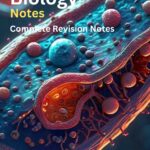 AQA GCSE Biology Notes
AQA GCSE Biology Notes
AQA GCSE Biology is a course offered by AQA (Assessment and Qualifications Alliance) in the United Kingdom for secondary school students typically aged 14–16. It is part of the General Certificate of Secondary Education (GCSE), which covers a wide range of subjects and serves as a qualification before students progress to further studies or employment.
In AQA GCSE Biology, students learn fundamental biological concepts and processes, such as:
- Cell Biology – Understanding cells, their structures, and processes such as cell division and specialization.
- Organisation – Studying the human body systems, organs, and how they're organized.
- Infection and Response – Exploring pathogens, immunity, and how the body defends itself.
- Bioenergetics – Covering photosynthesis and respiration.
- Homeostasis and Response – Investigating how the body maintains internal stability, including hormonal responses.
- Inheritance, Variation, and Evolution – Discussing genetics, natural selection, and evolution.
- Ecology – Understanding ecosystems, biodiversity, and the impact of human activity.
The course is assessed through exams at the end of the course, focusing on both theoretical knowledge and practical application of biology through experiments and data analysis.
7 units
·
315 lessons
|
Last updated: November 22, 2024
|
Please login to save the post
Notes
Flashcards
Questions
MCQ Quiz
Exam Study Notes
7 units
·
315 lessons
27 topics
8 topics
9 topics
2 topics
21 topics
2 topics
36 topics
2 topics
28 topics
4 topics
30 topics
1 topics
14 topics
26 topics
10 topics
15 topics
5 topics
14 topics
5 topics
4 topics
11 topics
16 topics
10 topics
15 topics
Flashcards
Will be Added soon.....
MCQ Quiz
1 found this helpful out of 2 votes
Helpful: 50%
Helpful: 50%
Was this page helpful?
